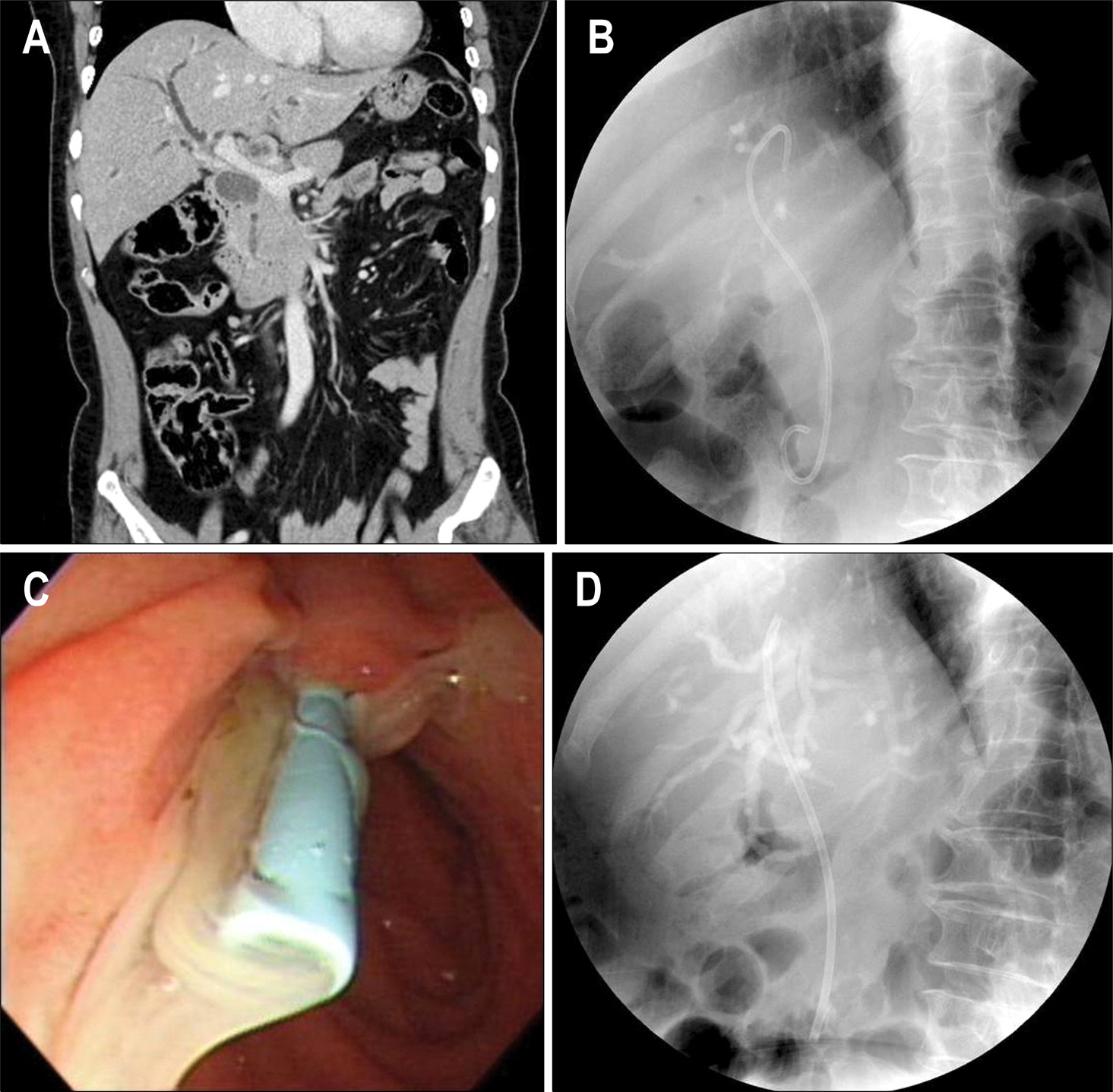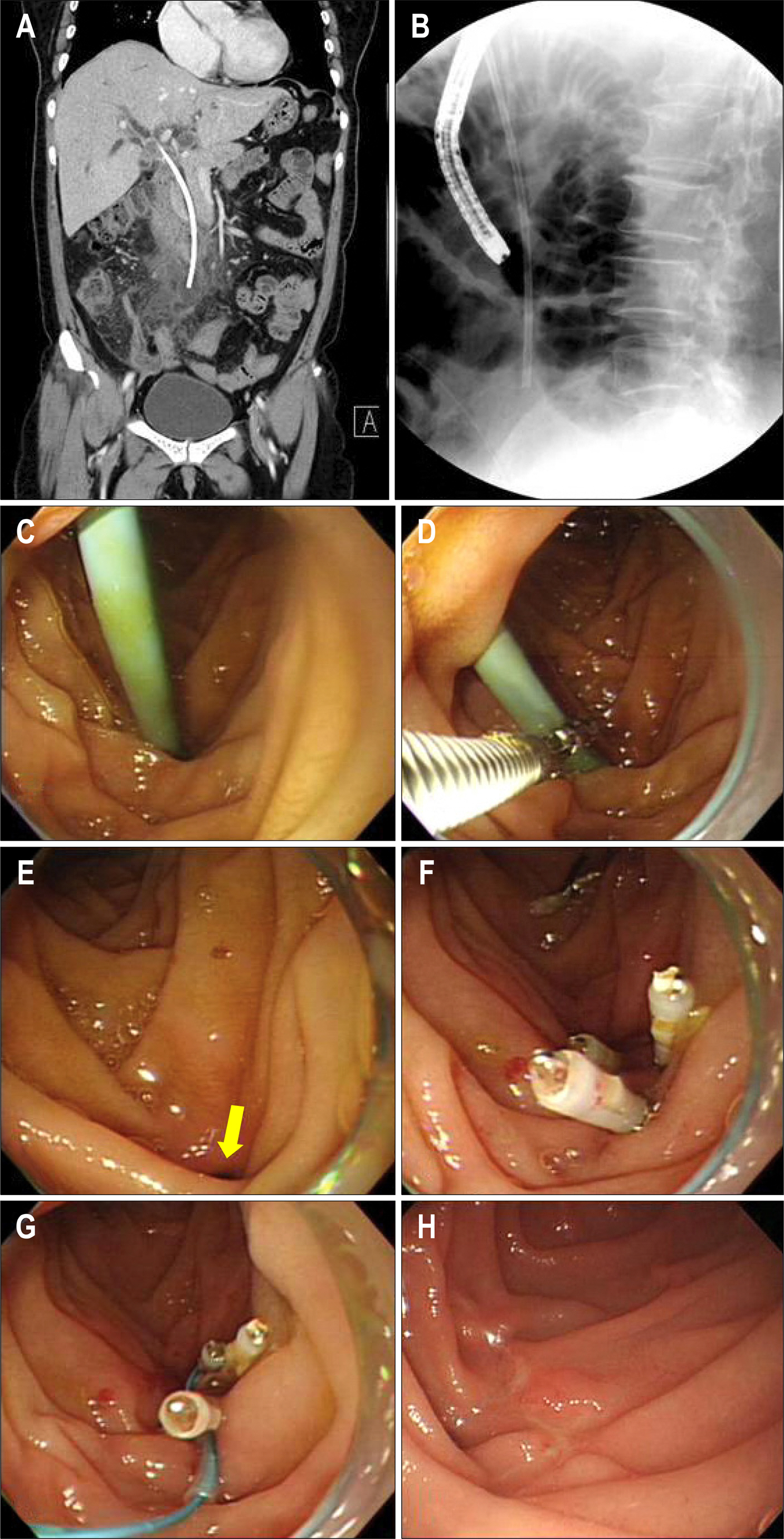Korean J Gastroenterol.
2011 Feb;57(2):129-133. 10.4166/kjg.2011.57.2.129.
A Case of Duodenal Perforation Caused by Biliary Plastic Stent Treated with Approximation using Endoclip and Detachable Snare
- Affiliations
-
- 1Department of Internal Medicine, Pusan National University School of Medicine, Busan, Korea. doc0224@pusan.ac.kr
- 2Department of Radiology, Pusan National University School of Medicine, Busan, Korea.
- KMID: 1775844
- DOI: http://doi.org/10.4166/kjg.2011.57.2.129
Abstract
- Endoscopic retrograde biliary drainage (ERBD) is useful for the palliative decompression of biliary obstruction. However, the complications of ERBD include cholangitis, hemorrhage, acute pancreatitis, obstruction of the stent, and duodenal perforation. Pressure necrosis on the duodenal mucosa by the stent may contribute to perforation. Although duodenal perforation following ERBD is very rare compared to other complications, it can result in a fatal outcome. Recent reports describe nonsurgical treatment for small gastrointestinal perforation with localized peritonitis and suggest that endoclipping may be appropriate in the management of a well selected group of patients with iatrogenic perforation. We describe a case of duodenal perforation secondary to ERBD that was successfully treated with approximating using endoclip and detachable snare.
Keyword
MeSH Terms
-
Bile Ducts, Extrahepatic
Biliary Tract Diseases/complications/surgery
Cholangiopancreatography, Endoscopic Retrograde
Drainage
Duodenal Diseases/*diagnosis/etiology/therapy
Female
Gallbladder Neoplasms/diagnosis
Humans
Intestinal Perforation/*diagnosis/etiology/therapy
Middle Aged
Plastics
Stents/*adverse effects
Tomography, X-Ray Computed
Figure
Cited by 2 articles
-
Unusual Complications Related to Endoscopic Retrograde Cholangiopancreatography and Its Endoscopic Treatment
Chang-Il Kwon, Sang Hee Song, Ki Baik Hahm, Kwang Hyun Ko
Clin Endosc. 2013;46(3):251-259. doi: 10.5946/ce.2013.46.3.251.An Unusual Case of Duodenal Perforation Caused by a Lollipop Stick: A Case Report
Eun Ae Cho, Du Hyeon Lee, Hyoung Ju Hong, Chang Hwan Park, Seon Young Park, Hyun Soo Kim, Sung Kyu Choi, Jong Sun Rew
Clin Endosc. 2014;47(2):188-191. doi: 10.5946/ce.2014.47.2.188.
Reference
-
References
1. Shim CS, Kim JH, Cho SW. Clinical study of endoscopic retrograde biliary drainage (ERBD) in malignant obstructive jaundice. Korean J Med. 1988; 35:644–651.2. Aliperti G. Complications related to diagnostic and therapeutic endoscopic retrograde cholangiopancreatography. Gastrointest Endosc Clin N Am. 1996; 6:379–407.
Article3. Trap R, Adamsen S, Hart-Hansen O, Henriksen M. Severe and fatal complications after diagnostic and therapeutic ERCP: a prospective series of claims to insurance covering public hospitals. Endoscopy. 1999; 31:125–130.
Article4. Gould J, Train JS, Dan SJ, Mitty HA. Duodenal perforation as a delayed complication of placement of a biliary endoprosthesis. Radiology. 1988; 167:467–469.
Article5. Cotton PB, Lehman G, Vennens J, et al. Endoscopic sphincterotomy complications and their management: an attempt at consensus. Gastrointest Endosc. 1991; 37:383–393.
Article6. Lee DK. Perforation and others. Korean J Gastrointest Endosc. 2003; 27:321–325.7. Lammer J, Neumayer K. Biliary drainage endoprostheses: experience with 201 placements. Radiology. 1986; 159:625–629.
Article8. Rosés LL, Ramirez AG, Seco AL, et al. Clip closure of a duodenal perforation secondary to a biliary stent. Gastrointest Endosc. 2000; 51:487–489.
Article9. Soehendra N, Reynders-Frederix V. Palliative biliary duct drainage. A new method for endoscopic introduction of a new drain. Dtsch Med Wochenschr. 1979; 104:206–207.10. You YK, Moon JH, Lee MS, et al. A case of duodenal perforation following endoscopic biliary drainage (EBD). Korean J Gastrointest Endosc. 1992; 12:91–97.11. Avgerinos DV, Llaguna OH, Lo AY, Voli J, Leitman IM. Management of endoscopic retrograde cholangiopancreatography: related duodenal perforations. Surg Endosc. 2009; 23:833–838.
Article12. Miller G, Yim D, Macari M, Harris M, Shamamian P. Retroperitoneal perforation of the duodenum from biliary stent erosion. Curr Surg. 2005; 62:512–515.
Article13. Binmoeller KF, Grimm H, Soehendra N. Endoscopic closure of a perforation using metallic clips after snare excision of a gastric leiomyoma. Gastrointest Endosc. 1993; 39:172–174.
Article14. Baron TH, Gostout CJ, Herman L. Hemoclip repair of a sphincterotomy-induced duodenal perforation. Gastrointest Endosc. 2000; 52:566–568.
Article15. Kaneko T, Akamatsu T, Shimodaira K, et al. Nonsurgical treatment of duodenal perforation by endoscopic repair using a clipping device. Gastrointest Endosc. 1999; 50:410–413.
Article16. Pontecorvo C, Pesce G. The ‘safety snare’–a ligature-placing snare to prevent haemorrhage after transection of large pedunculated polyps. Endoscopy. 1986; 18:55–56.17. Hachisu T. A new detachable snare for hemostasis in the removal of large polyps or other elevated lesions. Surg Endosc. 1991; 5:70–74.
Article18. Lee DW, An SG, Lee SM, et al. A case of gastric perforation due to endoscopic mucosal resection managed by detachable snare and hemoclips. Korean J Gastrointest Endosc. 2005; 30:199–203.19. Lee BI, Choi KY, Kim BW, et al. Approximation of large mucosal defects after endoscopic mucosal resection: a new technique using a detachable snare and clips. Gastrointest Endosc. 2004; 59(5):P150.
Article
- Full Text Links
- Actions
-
Cited
- CITED
-
- Close
- Share
- Similar articles
-
- Endoscopic Band Ligation in Endoscopic Retrograde Cholangiopancreatography Related Duodenal Perforation
- A Case of Gastric Perforation due to Endoscopic Mucosal Resection Managed by Detachable Snare and Hemoclips
- A Case of Endoscopic Unroofing after Detachable Snare Ligation of a Duodenal Duplication Cyst
- Endoscopic Removal of Bleeding Duodenal Lipoma Using a Detachable Snare
- A Successful Management of Ruptured Duodenal Varix by Means of Endoscopic Ligation with Detachable Snare



